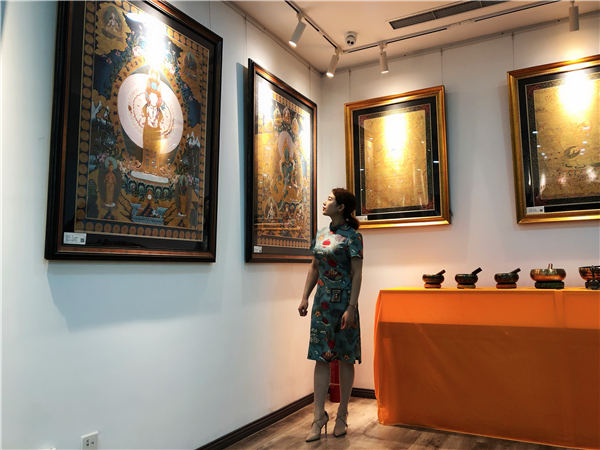Exhibition of Nepalese paintings promotes cultural relationships
 0 Comment(s)
0 Comment(s) Print
Print E-mail China Daily, April 26, 2019
E-mail China Daily, April 26, 2019

A total of 30 thangka paintings from top Nepalese artists are on display in Beijing, as part of efforts to promote cultural exchanges between China and Nepal.
Thangka is a Buddhist scroll painting on cotton or silk. The art has more than 1,300 years of history and typically depicts Buddhist deities. Such paintings use mineral and organic pigments derived from coral, pearl, agate, sapphire, gold and other materials, so that the color stays vibrant for centuries, which makes them invaluable both in artistic and commercial terms.
Thangka is an important art form in Nepal, and also plays an important role among the Tibetan ethnic group, as both share the Buddhist culture.
The Belt and Road Initiative: Nepal Thangka Art Exhibition is co-organized by Art Kathmandu, an art gallery in Nepal, and the China Nepal Cultural Exchange Center. The exhibition is open to the public through May 5.
"Nepal and China are connected by geography, history and culture. The historically rich cultural relations between the two countries have evolved over thousands of years. Buddhism is one of the bridges which linked Nepal and China, since time immemorial," said Harishchandra Ghimire, minister counselor from the Embassy of Nepal in Beijing, at the opening ceremony earlier this month.
Lumbini in southern Nepal is the birthplace of Shakyamuni Buddha. China also has many sacred Buddhist sites, such as the Wutai and Putuo mountains. Besides the economic benefits, such cultural exchanges can help bring people from different countries closer, says Zhang Shubin, director of the Nepal Study Center at Hebei University of Economics and Business.
The exhibition is a good warmup activity for the ongoing second Belt and Road Forum for International Cooperation, he adds.
The exhibits show the life of Buddha from birth to the attainment of nirvana and the images of different Buddhist deities.
For example, one painting shows how Shakyamuni was born from the armpit of his mother and how seven lotuses generated from his seven footprints.
In another painting, Manjusri, an avatar of the Buddha who represents transcendent wisdom, is depicted. He is said to have shaped Kathmandu, the capital of Nepal, with his sword.
The painting with the thousand-hands and thousand-eyes Guanyin, or Avalokitesvara bodhisattva, shows the ability to see all suffering on Earth and give blessings to more people, according to Bhusan Kayastha, a research scientist at the National Astronomical Observatories of the Chinese Academy of Sciences in Beijing and CEO of Art Kathmandu, a co-organizer of the exhibition.
"Each deity has their unique iconography. Some look fierce, with red or blue-colored skin, or by holding a weapon, but that only serves to show their power and ability to fight the devil and protect people," he says.
"Thangka paintings are a beautiful art form. You don't have to be a Buddhist to admire them," he says. "They can help calm you down when you are tired or angry."
There are also silk fans from Suzhou, Jiangsu province, on display, upon which Buddhist patterns are painted by Nepalese artists.
"These fans represent the true spirit of the China-Nepal cultural exchange," he adds.
Wei Jiahui, 19, a college student in Beijing, says he was happy to visit the exhibition and learn about a different culture. He says the show for him was "a good chance to acquire some new knowledge" about Buddhism.






Go to Forum >>0 Comment(s)